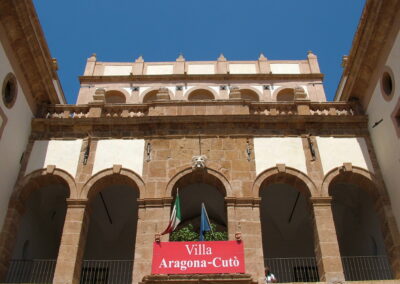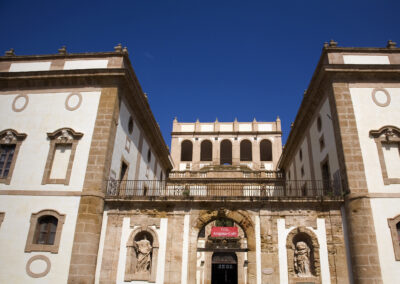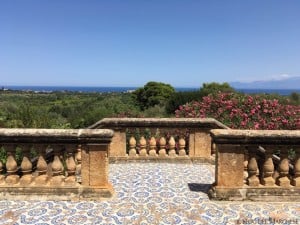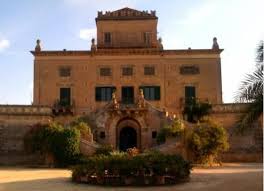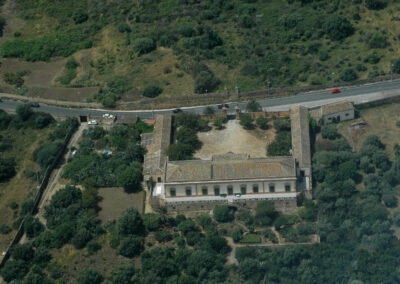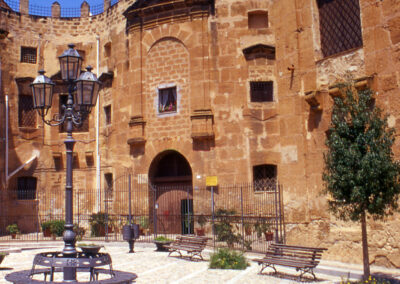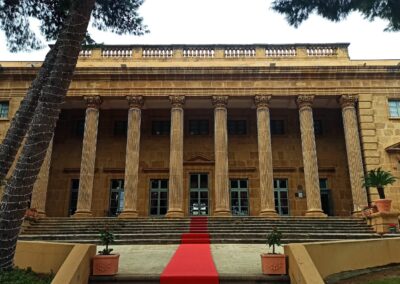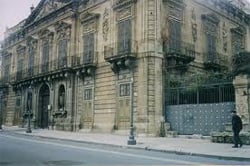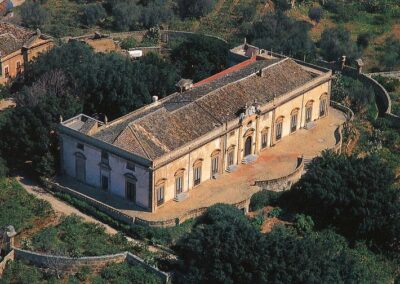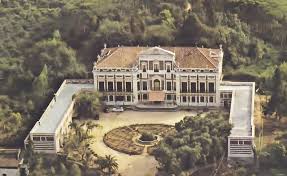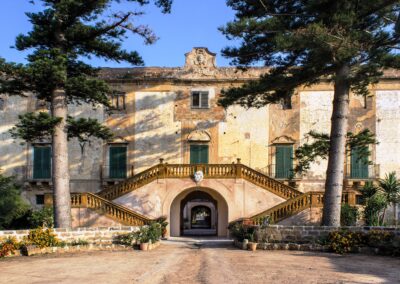Villa Aragona Cutò – Municipal library
t was built in the first half of the eighteenth century at the behest of Prince Luigi Naselli of Aragona and can be accessed from the ancient Via Consolare. The heraldic emblem of the family is represented by the busts of young lions placed to decorate the tympanums of the windows. The rooms, with their showy red marble decorations and coverings, take on a tone of elegant aesthetic taste, accentuated by the visible remains of precious decorations that cover the vaulted ceilings. The palace, made up of a large quadrilateral complex, is surmounted by a vast covered terrace, from which the prince enjoyed a very suggestive panorama. It seems that he used to admire, together with friends of the Palermo nobility, the fireworks that were prepared in the gulf of the Conca d’Oro, on the occasion of the “Festino” of S. Rosalia in Palermo.
Complex patrimonial events prelude the transfer of ownership in 1908 from Prince Alessandro Tasca di Cutò to his nephew Giuseppe Tomasi di Lampedusa, the famous writer and author of “The Leopard”, ending up in bourgeois hands in 1923.
Purchased by the Municipality in 1991, after the restoration based on a project by the architect Antonio Belvedere, the Palazzo currently houses the “F. Scaduto Municipal Library”.
Palazzo Cutò
Management 091 943093
Offices 091 943094
Opening hours to the public
– Tuesday through Friday: 8:30 a.m. to 1:30 p.m. and 3:30 p.m. to 6 p.m.
– Monday, Saturday and Sunday: 8:30 a.m. to 1:00 p.m.
Visits organized for groups and schools can be made by booking.
Deepening
Built between 1712 and 1716 by the will of the prince of Aragona, Luigi Onofrio Naselli, based on a design by the architect Giuseppe Mariani, the Palazzo Aragona Cutò is located in via Consolare near the railway station of the city of Bagheria.
It has a massive quadrangular structure, surmounted by a vast loggia-belvedere, the view of which in the distance intrigues and attracts.
From this loggia in ancient times the prince and the nobility of Palermo used to watch the theatrical performances and fireworks of the “festino” of S. Rosalia of Palermo and still today from this covered terrace it is possible to enjoy the evocative panorama of the city of Bagheria and the splendid Gulf of Palermo.
On the pediment on either side of the main entrance, inside niches, there are two allegorical statues, today maimed, in tufa stone while busts of young lions, which decorate the tympanums of the main openings, represent the heraldic emblem of the Naselli Aragona.
The main floor is accessed from the ground floor via a monumental staircase with two symmetrical ramps, the closure of which inside the courtyard is a real rarity for a country villa.
In fact, this Palace is the only one not to have that external staircase which was one of the main features of the Sicilian villas of the time.
The service areas are located on the ground floor, while the owners lived on the first floor.
The frescoes, still visible, executed around 1726 on the vaults of the large rooms of the main body in which mythological subjects were depicted such as The Judgment of Paris, Love of Venus and Mars, Mercury and Argos, Hercules and Antaeus and subjects are attributed to Willem Borremans taken from the New Testament such as the Annunciation, Visit of the shepherds, Visit of the Magi, Flight into Egypt.
In 1803 this large summer residence, which formerly belonged to the Princes of Aragon, was sold to Alessandro Filangeri, Prince of Cutò, for which the signs with a wrought iron monogram on the entrance door were changed.
Complex patrimonial events prelude the transfer of ownership in 1908 from Prince Alessandro Tasca di Cutò to his nephew Giuseppe Tomasi di Lampedusa, the famous writer and author of “The Leopard”, ending up in bourgeois hands in 1923.
Purchased by the Municipality in 1991, after the restoration based on a project by the architect Antonio Belvedere, the Palace currently houses the Civic Library “F. Scaduto” but inside it also houses the Toy Museum “Pietro Piraino”, open to visitors and of significant artistic value.
Its internal and external space is offered almost daily for guided tours and various cultural events, such as art exhibitions, conferences, concerts, shows of all kinds, book presentations, in which a large part of the public takes part with keen interest.
In this category

